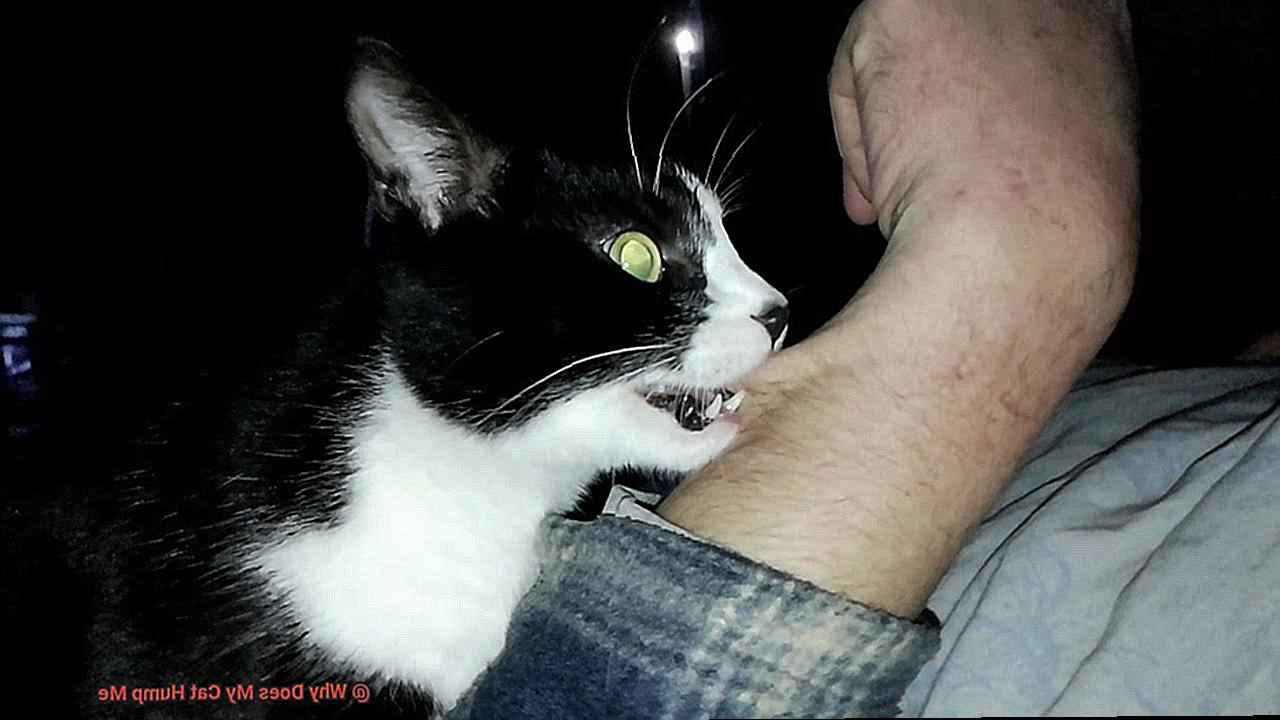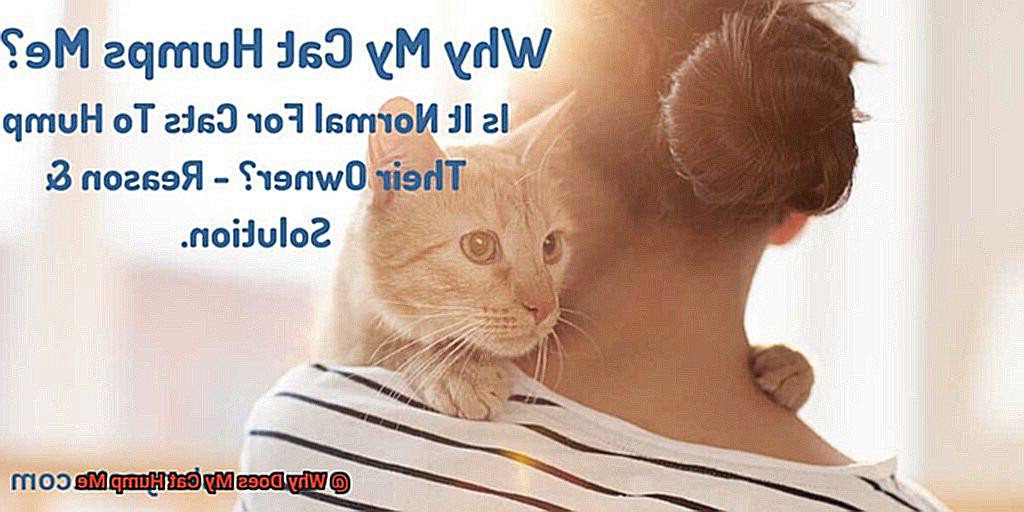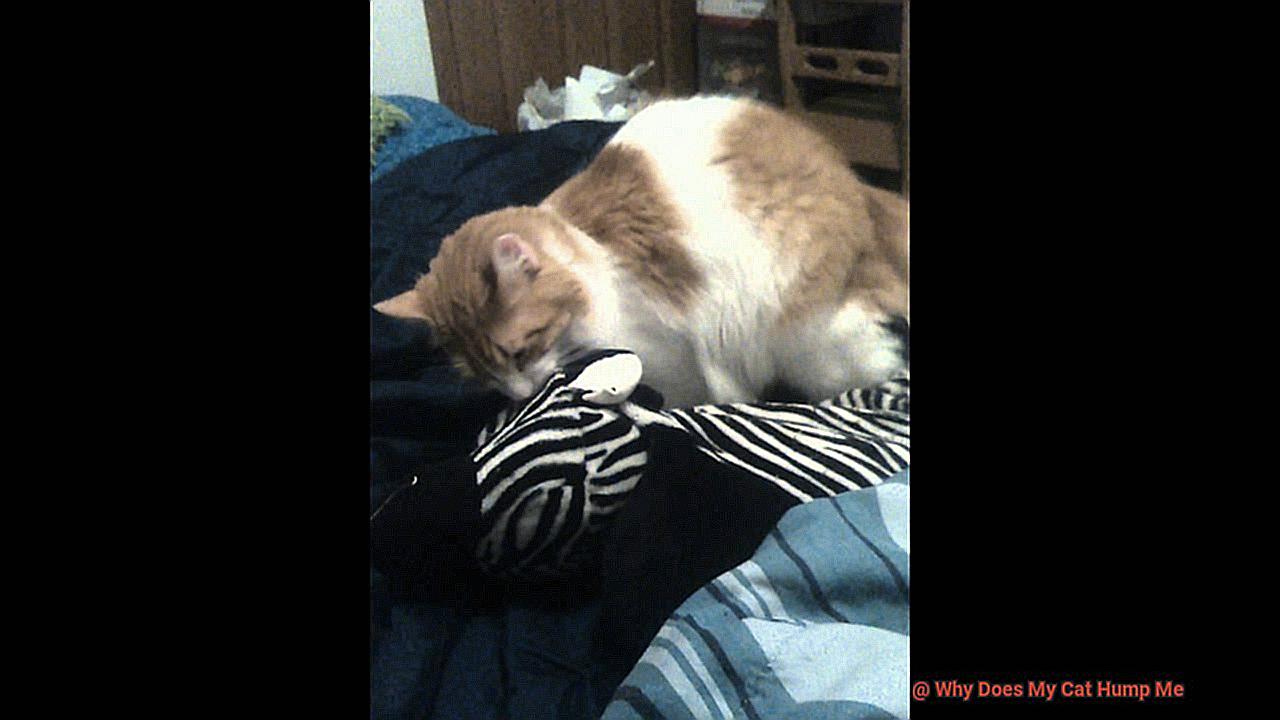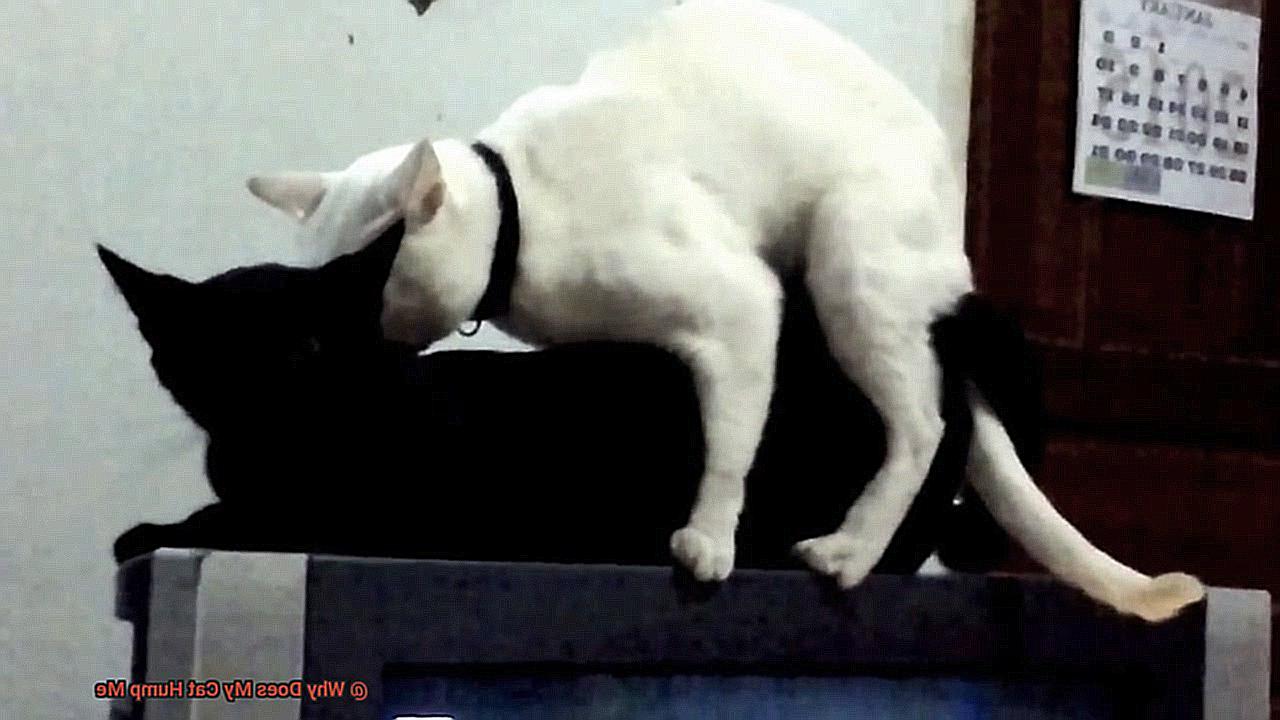Cats are fascinating creatures that can be both unpredictable and affectionate.
They have a way of making us feel loved one minute, and then scratching our furniture the next. But what happens when your cat starts humping you?
It’s not something we expect from our furry friends, and it can leave us feeling confused and uncomfortable. So why do cats hump their owners or objects around them?
It’s a question that has been asked by many cat owners, and one that we aim to answer in this blog post. Are they trying to show dominance or mark their territory?
Or maybe they’re just feeling frisky? In this post, we’ll take a deep dive into the world of feline behavior with insights from experts who have studied this peculiar behavior.
We’ll explore the differences between male and female cats, which age group is more likely to exhibit this behavior, and whether or not it’s something to be concerned about.
In this post, you’ll have a better understanding of why your cat may be engaging in this behavior and what you can do about it.

So, let’s get started.
What is Cat Humping?
Cat humping is a common behavior that can be caused by a variety of factors. Let’s dive into what cat humping really means and why it happens.
Cat humping is when a cat thrusts their hips forward in a rhythmic motion against a person, object, or other animal. While it may seem sexual, it’s essential to note that it’s not always related to sexual desire.
In fact, cat humping can have different causes such as dominance, playfulness, and stress. Cats may hump to assert their dominance over another person or cat.
It can also be a way of expressing excitement or playfulness. On the other hand, it can be a sign of stress or anxiety.
Cats that feel anxious or overwhelmed may engage in this behavior as a way of coping with their emotions. It’s essential to observe your cat’s behavior and try to identify any triggers that may be causing them stress or anxiety.
If you notice excessive or aggressive humping behavior, it may be necessary to consult with a veterinarian or animal behaviorist for guidance on how to manage the behavior. Moreover, it’s crucial to understand that humping can also be a sign of sexual frustration.
Cats that are not neutered or spayed may experience sexual frustration, which can lead to humping behaviors. Exposure to other cats that are in heat may also cause your cat to display humping behaviors.
Reasons Why Cats Hump Their Owners
It’s important to understand that this behavior is not a sign of aggression or dominance.
In fact, there are several reasons why cats may hump their owners or other cats, and understanding these reasons is key to managing this behavior effectively. First on the list is sexual behavior.
Unneutered male cats are more likely to exhibit this instinctive behavior during mating season, but it can also happen to female cats. Humping is a natural behavior that allows cats to assert their dominance and mark their territory.
If your cat is not neutered or spayed, this could be the reason why they’re humping. Stress and anxiety can also trigger unusual behaviors in cats, including humping.
If your cat is feeling overwhelmed or anxious, they may use humping as a coping mechanism. Identifying the root cause of your cat’s stress and working towards reducing it can help manage this behavior.
Cats are playful animals, and humping may be a part of their play behavior. This type of humping is usually non-sexual and may occur when your cat is feeling playful or excited.
It’s important to distinguish this type of humping from sexual behavior, as it doesn’t necessarily require intervention. Lastly, humping behavior may be a sign that your cat has a medical issue such as hormonal imbalances like hyperthyroidism or adrenal gland problems.
If you suspect your cat’s humping behavior is due to a medical issue, consult with your veterinarian. In conclusion, understanding the underlying cause of your cat’s humping behavior is crucial for addressing this issue effectively.
Is Cat Humping Normal?
It’s understandable to feel puzzled by this behavior, but the truth is that it’s completely normal for felines.
However, it’s important to be aware of the reasons behind your cat’s humping and address any issues that may arise. Firstly, it’s crucial to differentiate between sexual and non-sexual humping.
Sexual humping typically occurs in male cats who haven’t been neutered. If your male cat displays sexual behavior, it’s best to have them neutered to prevent unwanted pregnancies and aggressive behaviors.
Non-sexual humping, on the other hand, can happen in both male and female cats for various reasons such as anxiety, playfulness, or even dominance. It’s essential to observe your cat’s behavior closely and determine the root cause of their humping.
Sometimes, cats may also exhibit humping behavior due to redirected aggression. For example, if your cat spots another feline outside and becomes agitated, they may redirect their aggression towards you or an object by humping.
If you’re worried about your cat’s humping behavior, don’t hesitate to consult your veterinarian. They can help identify any underlying medical conditions that may be contributing to the behavior and offer advice on how to address it.
How to Respond to Cat Humping

Cats are fascinating creatures that have many instinctual behaviors, and humping is one of them. While this behavior is natural for cats, it can be uncomfortable or even alarming for their human companions. If you’re wondering how to respond to cat humping, here are five subtopics to guide you:
Stay Calm
When your cat starts humping, it’s essential to remain calm and not react in a way that could scare or startle them. Cats are incredibly attuned to their human’s emotions, so it’s important to project a sense of calm.
Distract Your Cat
If you notice your cat starting to hump, try distracting them with a toy or treat. This can redirect their attention away from the behavior and onto something more appropriate.
Remove Yourself
If your cat continues to hump despite your attempts to distract them, it may be best to remove yourself from the situation. This can help prevent any potential injuries or discomfort.
Consult with Your Vet
If your cat’s humping behavior becomes excessive or starts to interfere with their daily life, it’s important to consult with your veterinarian. They can help identify any underlying medical or behavioral issues and provide guidance on how to address them.
Redirection
Ignoring the behavior or redirecting your cat’s attention to more appropriate activities such as providing toys, engaging in interactive play, or giving them access to scratch posts can help discourage humping behavior.

It’s essential to understand that responding to cat humping requires patience and understanding. Humping is a natural behavior for cats, particularly those who are not spayed or neutered.
However, if your cat is humping excessively or displaying other concerning behaviors, consulting with a veterinarian or animal behaviorist may be necessary.
When to Seek Professional Help
When it comes to their humping behavior, things can get awkward and uncomfortable for us humans.

While some cases of cat humping can be managed at home, there are situations where it’s necessary to seek professional help. If your cat’s humping behavior has suddenly changed or become more frequent and aggressive, it could be a sign of an underlying medical issue.
Hormonal imbalances, urinary tract infections, or neurological disorders can cause unusual sexual behavior in cats. In these cases, it’s crucial to seek professional help from your veterinarian.
They can perform a thorough examination and run any necessary tests to determine if there is an underlying medical issue causing your cat’s behavior. It’s also vital to seek professional help if your cat’s humping is causing harm or discomfort to you or them.
Scratches, bites, or injuries from excessive force during humping can be serious and require immediate attention. Your veterinarian or a certified animal behaviorist can provide guidance on how to manage this behavior and keep both you and your cat safe.
It’s worth noting that not all cases of cat humping require professional help. In some instances, it may simply be a normal behavior for your cat, especially if they were not spayed or neutered when they were young.
However, if you’re unsure about whether your cat’s humping is normal or requires professional help, it’s always best to err on the side of caution and seek guidance from a veterinarian or animal behaviorist. In conclusion, seeking professional help is necessary when your cat’s humping behavior has suddenly changed or become harmful or uncomfortable.
Remember that seeking professional help is always the best course of action when it comes to our beloved feline friends.
HdP1wQrSBV0″ >
How to Prevent Cat Humping
Spaying or Neutering Your Cat
Spaying or neutering your cat is one of the most effective ways to prevent cat humping. This procedure not only reduces the likelihood of your cat engaging in humping behavior, but it also has several other health benefits.
By reducing hormonal influences that trigger such behaviors, you can help your cat lead a happier and healthier life.
Talk to your veterinarian about scheduling the procedure for your feline friend.
Distracting Your Cat
When you notice your cat starting to engage in humping behavior, distract them with a toy or treat. Alternatively, you can simply move away from them until they stop the behavior.
However, it’s important to avoid punishment or aggression towards your cat as this can worsen the situation and lead to more behavioral issues. Instead, try positive reinforcement techniques to encourage good behavior.
Providing Plenty of Exercise and Playtime
Cats that do not get enough exercise or mental stimulation may be more likely to engage in humping behaviors. To prevent this, provide your cat with plenty of exercise and playtime.
This can include playing with toys, providing scratching posts and climbing trees, or even building an obstacle course for them to explore. Interactive toys and puzzles can also help keep your cat mentally stimulated and less likely to engage in humping behavior.
Establishing Clear Boundaries
Establishing clear boundaries with your cat is crucial when preventing humping behavior. If you notice your cat starting to exhibit this behavior, calmly say “no” and redirect their attention to something else.
Reinforce positive behavior by rewarding them with treats or affection when they behave appropriately. Consistency is key when establishing boundaries with your cat, so be sure to enforce these rules consistently.
Seeking Professional Help
If your cat’s humping behavior persists or becomes problematic, it may be necessary to seek professional help.
A veterinarian or animal behaviorist can provide additional guidance and advice on how to manage this behavior effectively. They may also be able to recommend alternative therapies or treatments that can help reduce your cat’s humping behavior.
Remember, preventing cat humping is a process that requires patience and consistency, but with the right approach, you can help your cat overcome this behavior and maintain a happy and healthy relationship with them.
So, preventing cat humping may seem like a daunting task, but it’s not impossible.
By spaying or neutering your cat, providing plenty of exercise and mental stimulation, establishing clear boundaries, and seeking professional help if necessary, you can help your cat overcome this behavior.
Remember to be patient and consistent, and most importantly, show your feline friend love and affection throughout the process.
Also Read: Why Do Cats Hump Blankets?
Conclusion
In conclusion, while cat humping may seem peculiar to us humans, it’s a perfectly natural behavior for felines.
It can stem from various factors such as dominance, playfulness, stress, or even sexual frustration. To effectively address this issue, it’s essential to understand the underlying reason behind your cat’s humping behavior.
It’s crucial to differentiate between sexual and non-sexual humping and respond accordingly. Remaining calm, distracting your cat with toys or treats, removing yourself from the situation if necessary, consulting with your vet, and redirection are all effective methods of managing this behavior.
If your cat’s humping behavior suddenly changes or becomes harmful or uncomfortable, seeking professional help is necessary. Preventing cat humping requires patience and consistency by spaying or neutering your cat, providing plenty of exercise and mental stimulation, establishing clear boundaries, and seeking professional help if necessary.
By understanding their behaviors and needs, we can build a stronger bond with our furry friends and provide them with the love and care they deserve.







